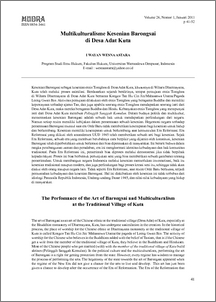I WAYAN , WESNA ASTARA
(2011)
The Perfomance of the Art of Barongsai and Multiculturalism
at the Traditional Village of Kuta.
Mudra (JURNAL SENI BUDAYA), 26 (1).
p. 1.
ISSN 0854-3461
![[img]](http://repo.isi-dps.ac.id/style/images/fileicons/application_pdf.png)  Preview |
|
PDF (The Perfomance of the Art of Barongsai and Multiculturalism at the Traditional Village of Kuta)
- Published Version
Download (768kB)
| Preview
|
Abstract
The art of Barongsai as an art of the Chinese ethnic at the traditional village (Desa Adat) of Kuta, especially at
the Bhuddhist monastery of Dharmayana, Kuta, has undergone assimilation in the creation. In the historical process, the place of worship for the Chinese ethnic at Dharmayana monastery at the traditional village of Kuta is called Kongco Tan Hu Cin Jin/ Mahasatwa Utama/the pagoda of Leeng Gwan Bio. The activity of worship for the Chinese who believes in the Buddhism added with the belief of Taoism, that is if the Chinese
get a wife from the member of the traditional village of Kuta, they believe in the Buddhism and Hinduism. Most of the Chinese people who got married (wife) with the member of the traditional village of Kuta build shrines (Pelinggih Sanggah Kemulan). In the political culture and the multiculturalism, performing the art
of Barongsai is a right for getting protection from the state. However, every regime has wisdom to manage
the process of performing the arts. The hegemony of the state towards the art of Barongsai appeared when
the regime of the New Era did not give a chance for the arts to live and develop. This art has just been given a chance to develop after the occurrence of the Era of Reformation. The Era of the Reformation that
Actions (login required)
 |
View Item |


